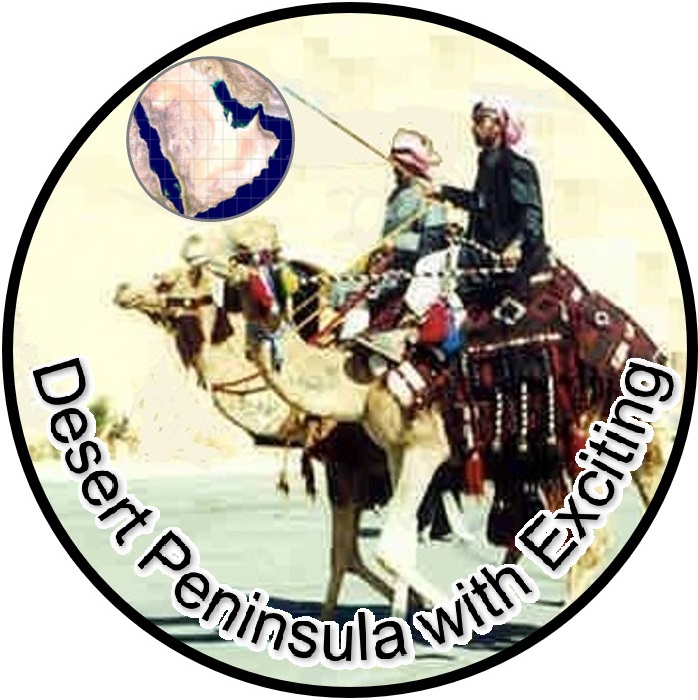Age of Arabian Felix (Kingdom of Sheba and Ma’in)
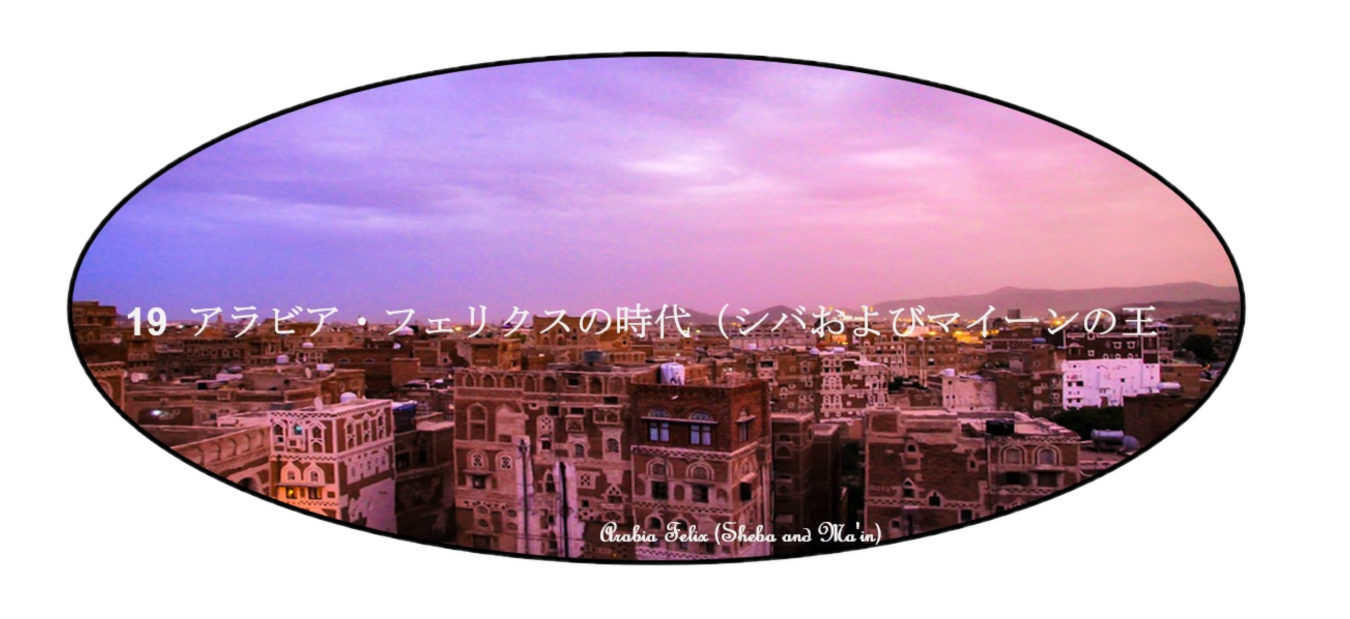
目次(Index)
はじめに
紀元前23世紀にアラビア半島南部のアラブ族は、カフターン族の支配下にまとまり、簡単な土盛りのダムと水路をサイハド沙漠のマアリブ地域に築いて農業を営んでいました。紀元前8世紀頃から紅海岸を利用する等、地中海と結んだ乳香交易や東洋からの香辛料中継で繁栄し、古代ギリシア・ローマでは「幸福のアラビア」を意味する「アラビア・フェリクス」と呼ばれていました。歴史家ヘロドトスは「世界で乳香が育つ唯一の国であり、没薬、桂皮、シナモンおよびラブダナムも産し、この世のものとは思えない匂いが発散している」と述べています。この地を征服する為にアレキサンダー大王は紀元前323年に海軍を遠征させています。ローマ皇帝アウグストゥスも紀元前25年にアエリウス・ガルスを派遣してマアリブを包囲しましたが、補給が続かずに6日間で退却してしまいました。ローマ人はその後も乳香交易を続け、紅海沿岸のモカ(ムザ)やアラビア海沿岸のカニー(カナ)の港を発展させました。3世紀の危機でローマ世界の経済も不振に陥り、乳香等の香料需要が落ち込みフェリクスは衰退してしまいました。
Introduction
In the 23rd century BC, the Arabs of southern Arabia came together under the rule of the Qahtan and farmed by building simple earthen dams and waterways in the Ma’rib region of the Sayhad desert (Ramlat al-Sab’atayn). From around the 8th century BC, it prospered in abundance through the frankincense trade and the oriental spice relay. Those were using the Red Sea Coast to connect with the Mediterranean Sea. In the ancient Greece and Rome, it was called “Arabian Felix”, which means “Arabia of happiness”. The historian Herodotus (484~420 BC) states that “it is the only country in the world where frankincense grows, and it also produces myrrh, cinnamon bark, cinnamon and labdanum.” He added “Those emit fragrant scents that don’t seem to be from the world.” To conquer the land, Alexander the Great (336~3A 23 BC) sent a naval expedition in 323 BC. The Roman Emperor Augustus (63 BC~14 AD) also sent Aelius Gallus to besiege Maarib in 25 BC, but he retreated after six days without continuous supplies. The Romans continued to trade in frankincense, developing the ports of Muza (present Mokha) on the Red Sea coast and Cane (Qana, near present Mukalla) on the Arabian Sea coast. The crisis of the 3rd century plunged the economy of the Roman world into a slump, and Felix declined as demand for frankincense and other fragrances fell.
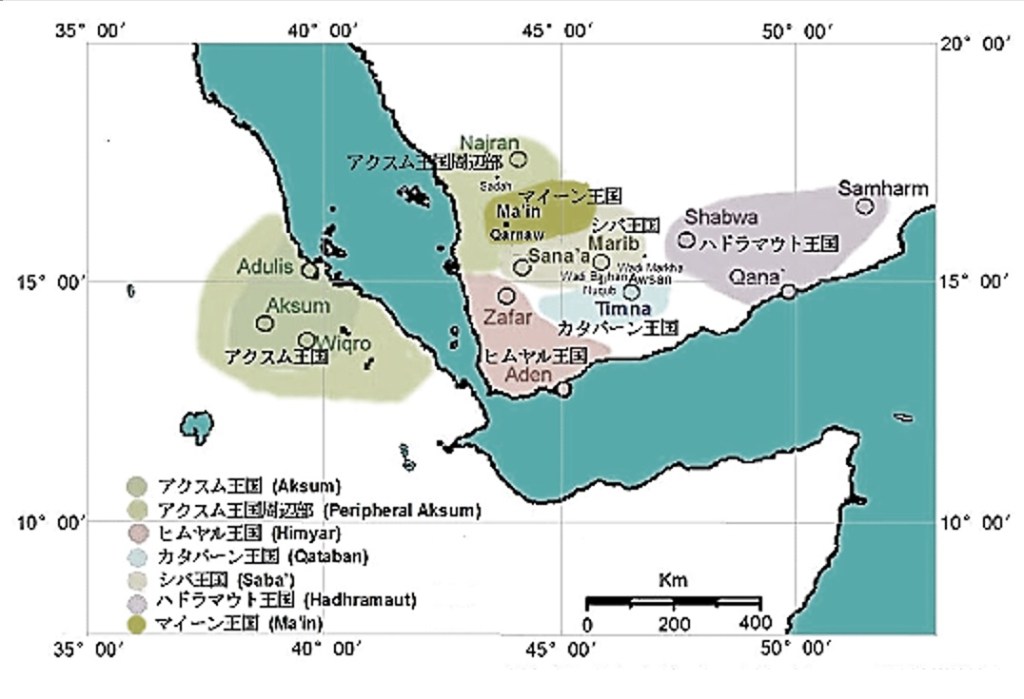

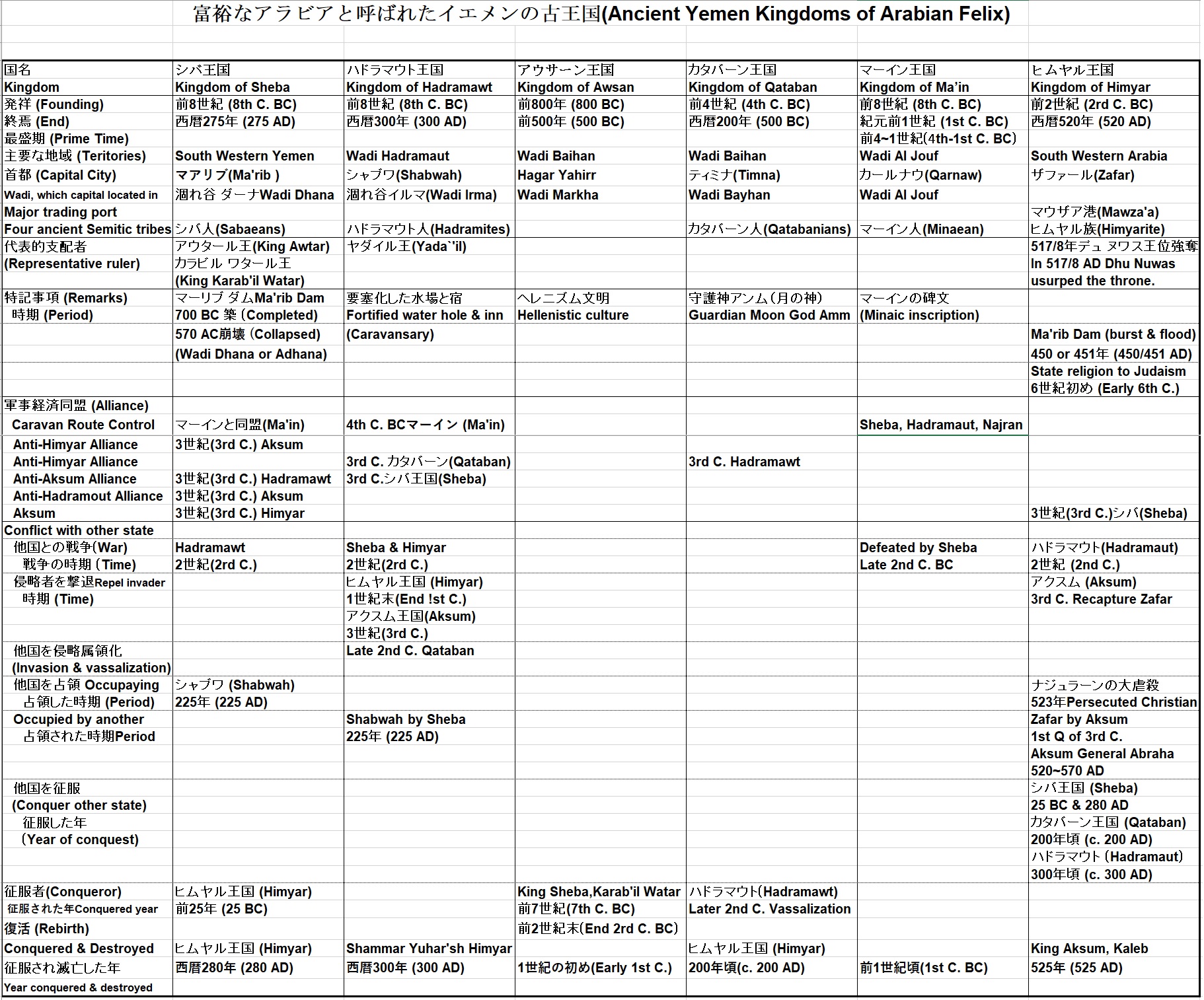
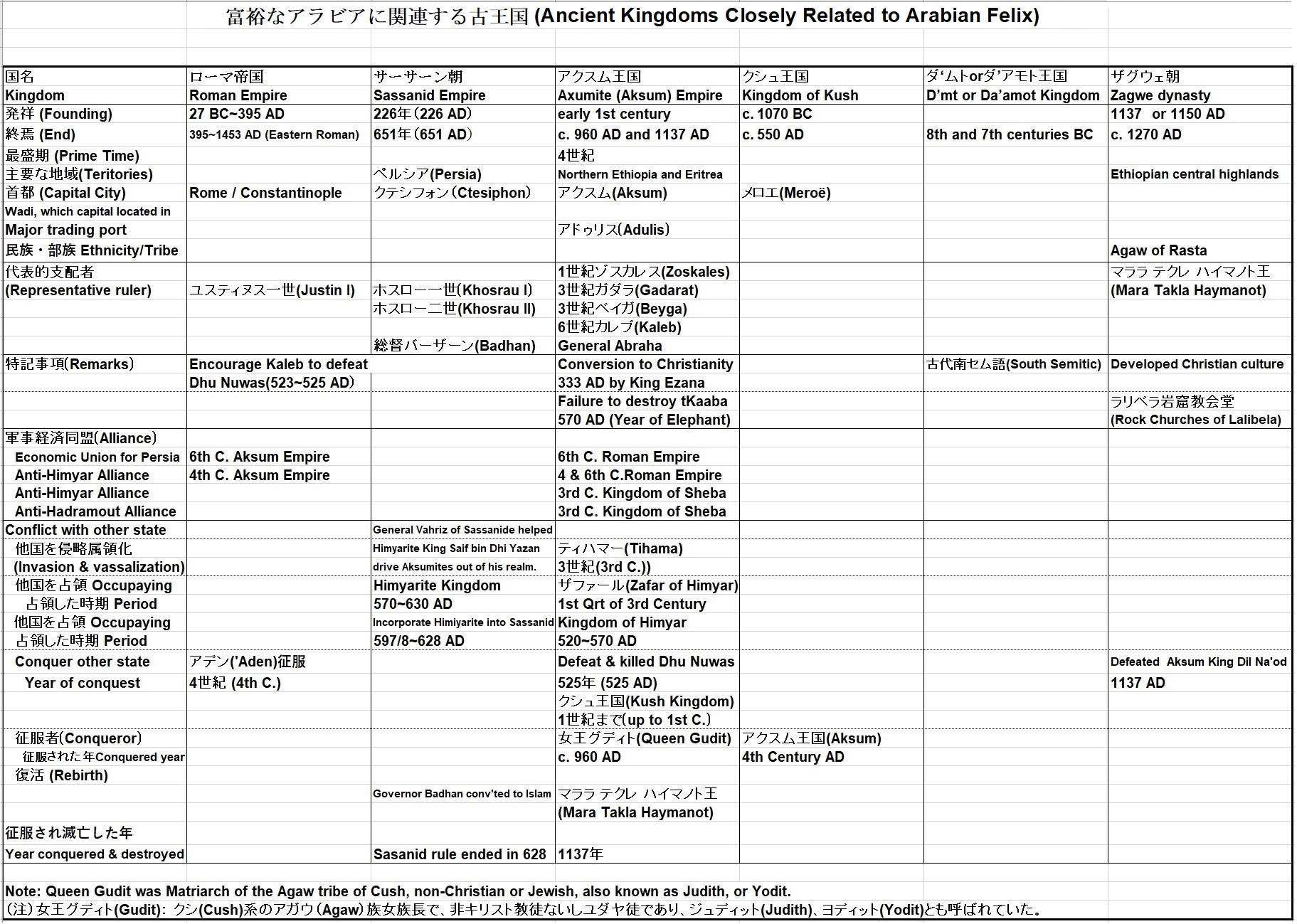
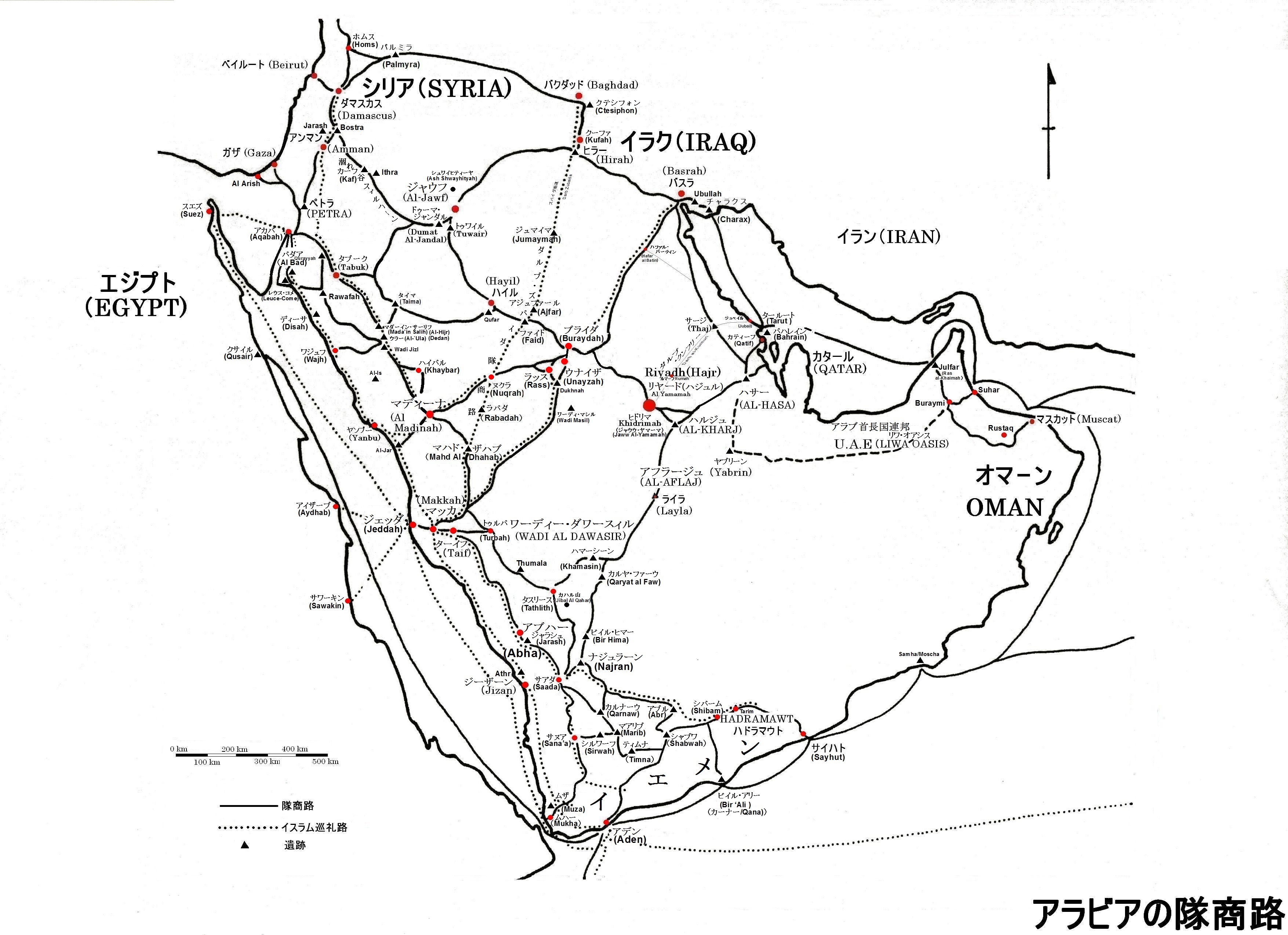
シバ王国
シバ(サバ)を名乗った人々の出現がもっとも早く、「ノアの長男セムがマアリブにシバ王国を創建してセム族の祖先に成った」と云われています。シバの女王は新旧の聖書およびクルアーンに言及され、王国の中心はサイハド沙漠西端のマアリブにありました。紀元前8 ~7 世紀にアッシリア年代記に記載されているシバの支配者は、祭式と灌漑に責任を持っていました。南東のアウサーン王国に勝利した長い碑文の記録を残っていますが、恒久的な征服には至りませんでした。また、ハドラマウト地域または紅海沿岸域の独立した部族にはシバ王国の支配は及んでいませんでした。マアリブに次ぐ中心はダム上流の涸れ谷ダーナの支流域にあるシルワーフおよび涸れ谷ジャウフの西端にあるナシュク(バイダー)でした。キリスト教の時代(紀元)の直ぐ前から、サヌアの北と西の両方の高地がシバ王国の支配にもっとも多くの役割を果たし、支配者の何人かはこの高地氏族に属していました。紀元1世紀にはサヌアが政治の中心で王のグムダーン(宮殿) としてサルヒン(宮殿)があったマアリブの地位にほぼ競合していましたが、それでもマアリブはその威信を紀元6 世紀頃まで保持しました。碑文に使う支配者の称号として支配者自身は「ムカッリブ(統一者)」を使い、それ以外の者は「マアリブの王」を使っていましたが、後に「シバの王」の称号使用で統一されています。
Kingdom of Sheba
It is said that the earliest people claiming the name of Sheba (Saba) appeared, and that “Noah’s eldest son, Shem, founded the Kingdom of Sheba in Ma’rib and became the ancestor of the Semites.” The Queen of Sheba (Makeda or Bilqis) is mentioned in the old and new Bibles and the Qur’an, and the center of her Kingdom was Ma’rib at the western end of the Sayhad desert. The rulers of Sheba, mentioned in the Assyrian chronicles in the 8~7th centuries BC, were responsible for rituals and irrigation. There is a long record of a victory over the Awsan Kingdom (800~500BC) in the southeast, but it did not lead to a permanent conquest. Also, independent tribes in the Hadramaut region or the Red Sea coast were not under the control of the Kingdom of Sheba. The second most central areas after Ma’rib were Sirwah (صرواح) in the tributaries of the Wadi Dhana upstream of the dam and Nashq (present Bayda’) at the western end of the Wadi al-Jawf. Shortly before the Christian Age, the highlands of both the north and west of Sana’a played the most roles in the rule of the Kingdom of Sheba, and some of the rulers belonged to this highland clan. In the 1st century AD, Sana’a was almost in conflict with the position of Ma’rib, which was the political center and had a Salhin (palace) as the king’s Ghumdan (غمدان) (palace), but Ma’rib still retained its prestige until about the 6th century AD. The rulers themselves used “Mukarrib (مكرب) (United)” as the title of ruler used in the inscription, while others used “King of Ma’rib”. But this was later unified by the use of the title “King of Sheba”.
初期のシバ王国の碑文に紀元前800~500年の間に存在したアウサーン王国の大敗北が記述されています。この王国は涸れ谷バイハーンの南の高地にあり、幾つもある他の王国の中でもっとも重要視されていた様です。アウサーン王国はもっと後の紀元の初め頃に短い復活があり、富裕でヘレニズム文化の影響を大きく受けていたとされています。紀元1 世紀以降、シバ王国もヒムヤル王国も、王達は自分自身の命令の下にある国軍カミスと各従属する地域社会を率いる貴族の一族に属するカイルの両方に支援されていました。同じような軍事態勢を持っていたにもかかわらず、紀元後の3 世紀間、シバ王国は南にいるヒムヤル王国からの強力な脅威に直面していました。ヒムヤル王国はシバ王国に対して覇権を得ることに時々、成功してはいましたが、紀元3 世紀の終わりにヒムヤル王国は決定的にシバ王国を自国領に吸収しました。
An early Sheba inscription describes the great defeat of the Awsan (أوسان) Kingdom that existed between 800~500 BC. This Kingdom is located in the highlands south of the Wadi Bayhan, and seems to have been the most important of the many other Kingdoms. The Kingdom of Awsan had a brief revival at the beginning of the A.D. much later, and is said to have been rich and heavily influenced by Hellenistic culture. From the 1st century AD onwards, both the Kingdom of Sheba and the Kingdom of Himyar were supported by both the national army Khamis (خميس), under his own orders, and the Qayls army, who belonged to an aristocratic family that led each subordinate community. Despite having a similar military posture, during the three centuries A.D. the Kingdom of Sheba faced a strong threat from the Kingdom of Himyar in the south. The Kingdom of Himyar sometimes succeeded in gaining supremacy over the Kingdom of Sheba, and at the end of the 3rd century AD the Kingdom of Himyar decisively absorbed the Kingdom of Sheba into its own territory.
マイーン王国
マイーン王国はこの時代の圧倒的に優勢な取引の組織であり、紀元前4 世紀から紀元前2世紀まで続き、主に貿易ルートを独占しました。マイーン人の初期の支配者は、「評議会と国家の代表」を兼ねる議会の中の1人であり、支配者の個人的な役割は主として建設と戦争にありました。マイーン王国に関する言及は早期のシバ王国の碑文に書かかれ、そこには涸れ谷ジャウフの東端のサイハド沙漠の西の境界に位置する首都カルナーウ(マイーン)北の碑文にはアーミル族と緩かに提携している様に述べられています。マイーン王国にはカルナーウの直ぐ南のヤシッル(バラーキシュ)にまだ現存する印象的な壁に囲まれた 第2の町がありました。そしてディーダーン、ナジュラーン(オクデュード)、カタバーンおよびハドラマウトの首都に交易所を持っていました。これ等は典型的な隊商都市であり、市の中心付近から遠く離れて領土を持つことはありませんでした。マイーン碑文の圧倒的多数は、カルナーウ、ヤシッルおよびディーダーンから発見されていますが、疎らに散らばるマイーン碑文は遠く離れていても明らかに取引活動のあったアラビア、エジプト、デロス島等の場所ですべて発見されています。そしてカルナーウからの発見された碑文には、ヤスリブ(マディーナ)やガザ地区などのキャラバン・ルート上の多くの重要な場所やエジプトとシリアのセレウコス朝の間の戦争の幾つかの段階によって貿易が中断されたことも記述されています。
Kingdom of Ma’in
The Kingdom of Ma’in (معين) (6th C~150 BC) was the dominant trading organization of this period, lasting from the 4th century BC to the 2nd century BC and monopolizing mainly trade routes. The early rulers of the Minaeans were one of the legislatures that doubled as “councils and representatives of the state”, and the personal role of the rulers was mainly in construction and war. References to the Kingdom of Ma’in are mentioned in early inscriptions of the Kingdom of Sheba. This inscription was installed at the north of the capital Qarnaw (present Ma’in). Qarnaw was located on the western border of the Sayhad desert at the eastern end of the Wadi al-Jawf. It indicates that the Kingdom of Ma’in was loosely allied with the ‘Amir (عامر) tribes. The Kingdom of Ma’in had a second town surrounded by impressive walls that still exists in Yathill (يثل) (present Baraqish (براقش)), just south of Qarnaw. And It also had trading posts in the capitals of Dedan, Najran (Okhdood (الأخدود)), Qatabanian and Hadramawt. These were typical caravan cities, and did not have territory far from the city center. The overwhelming majority of the Ma’in inscriptions have been found in Qarnaw, Yathill and Dedan. The scattered Ma’in inscriptions have also been found in places such as Arabia, Egypt and the island of Delos, where there was clearly a trading activity, albeit far away. And inscriptions found from Qarnaw also describe the interruption of trade at many important sites along the caravan routes, such as Yathrib (present Madinah or Medina) and the Gaza Strip. They also described the several phases of the wars between Egypt and Syria, during the Seleucid Empire (312~ 63 BC).
マイーン王国の社会構造は、主として農民で構成されるシバ、カタバーンおよびハドラマウト等の王国とは異なります。他の3王国が系譜に基づかず、覇権を持つ地域の名前で呼ばれる国としての地域社会の同盟であるの対し、マイーン王国はさまざまなサイズと重要度に細分化され、どれも他を支配する役割を持たず、幾つかは非常に小さなグループに分割されていました。他の3王国では「長老 (カビール) 」は同盟する地域の中の1つの首領が充てられたが、マイーン王国のカビールは、取引の為の定住地の頭か、いくつかの場合、それらのすべての投資への権限を持つ人物が隔年毎に任命されていました。立法機能は王によって、評議会とすべてのマイーン王国社会階級の代表者と共に実施されていました。マイーン碑文には王又は国によって行われた戦争の言及は無く、それがマイーン王国は交易路に沿って自分達の定住地に隣接する国々と安全通行権の保証協定を締結していたことを示唆しています。
The social structure of the Kingdom of Ma’in differs from those of Sheba, Qataban and Hadramawt, which were predominantly peasant. While the other three kingdoms are not based on genealogy and are communal alliances as nations called by the name of their hegemonic region, the Kingdom of Ma’in was subdivided into varying sizes and degrees of importance, each subdivided not dominating the other subdivided. Some of them were further split into very small groups. While in the other three kingdoms the ‘kabir’ was assigned to be the head of one of the allied regions, in the Kingdom of Ma’in the Kabir was simply the head of a trading settlement. In some cases, a person with authority over all investments was appointed as the Kabir every other year. The legislative functions were carried out by the king, together with councils and representatives of all social classes in the Kingdom of Ma’in. There is no mention of wars waged by the kings or the nation in the Ma’in inscriptions, which suggested that the Kingdom of Ma’in had concluded right-of-way guarantee agreements with the countries adjacent to their settlements along their trade routes.
